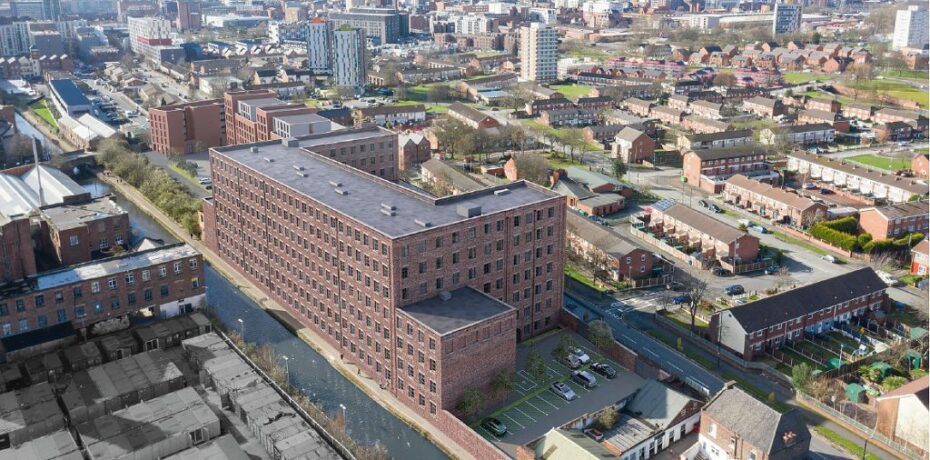The Subplot
The Subplot | Small lenders, old mills, big hair
Welcome to The Subplot, your regular slice of commentary on the North West business and property market from Place North West.
THIS WEEK
- Filling up the tank: smaller lenders refuel the North West property market
- Don’t forget mills: the region’s 16m sq ft property asset re-examined
- The WeWork of hair: the latest high street concept arrives

FILLING UP THE TANK
 Smaller lenders refuel the NW property market
Smaller lenders refuel the NW property market
Property lenders are active again, with loan volumes now back to pre-pandemic levels. Small lenders, many in the North West or focusing on the North West, are leading the way.
You can almost feel the weight of money looking for a way to squeeze into the region’s real estate. Within a few minutes yesterday morning it was confirmed that Mitsubishi Estate subsidiary Europa Capital signed up to forward-fund Mulbury’s 161-unit BTR scheme at Bendix Street, Manchester, and that Tristan Capital Partners’ EPISO 5 Fund bought the Qbic hotel building, Deansgate/John Dalton Street, the first buy for its £400m plus European hotel fund. Most UK cities would regard that as a good haul for a month; in Manchester, it is a decent start to the week.
Grease monkeys
While the big schemes grab the headlines, much of the vital work of greasing the wheels of the region’s property business is in the hands of smaller lenders. For instance, Cheadle-based property lender Together says loan volumes have bounced back to pre-pandemic levels. Volumes in the first six months of this year were a third up on the last six months of last year, and monthly loan origination surged from an average of £59m in H2 2020 to a healthy £136m in H1 2021. The best month, June, saw £190m signed off. No doubt by now that figure looks small.
Local heroes
Data from London’s Bayes Business School shows lending activity was particularly resurgent among lenders with smaller balance sheets (under £1bn). In the first half of 2020, large balance sheet lenders still held a share of 59% of new business, but that fell back to 35%. Smaller lenders ticked up to 44%. Smaller lenders may be winning business by taking on lower-quality business: loan-to-value ratios are higher, and the weighted average default rate of portfolios is about twice as high as larger lenders (11%).
Margins grow
Terms are hardening with margins for some sectors (offices and industrial, particularly) up by between 12 and 22 basis points, according to data from Bayes. Total new UK commercial property lending in the first half of 2021 totalled £23.3bn, back to 2019 levels, although most of this was refinancing of one kind or another. Bayes said new development lending was just 20% in the first six months, which may be something to watch.
We need a bridge
There’s also increased appetite for bridging loans, suggesting a slightly gummy lending scene in which there’s a lot of money, but also plenty of caution. “There’s no denying pricing came in during the pandemic, and we’ve done retail, leisure and hospitality property with caution,” says Alex Garland, Together’s head of corporate lending. “And we’re finding lots of borrowers needing the short-term fix of bridging loans. But we need to understand their exit strategy and know that they are robust.”
Gear change
These short-term loans are greasing the wheels of a property lending scene that is running vastly smoother than it did 12 months ago, but sometimes seems to be seriously declutched. The engine is running but the gears aren’t always engaged and so the region has bridging loans from smaller lenders to thank for much of this autumn’s activity. For example, look at the £117m Manchester Tower site, West Whitworth Street.
And this is how it works
Octopus Finance and Wildhorn Properties have provided a £9m bridging loan to a joint venture between Featherfoot Whitworth Street and Altrincham-based EGCC Group to complete the purchase of the site for a 327-apartment scheme. Development finance of £78m has also been agreed but will only be triggered once 30% of the 327 apartments within the tower have sold. All being well, work on site will be completed by spring 2025.
Spread your bets
Bridging loans aren’t the full story. Together, like everyone else, would like to get more into last-mile logistics and warehousing. “The difficulty there is trying to find value,” says Garland, of a sector suffering from notoriously low yields. Private investors are also stepping back from this sector: Bolton-based Pitalia reported concerns to Subplot earlier this year (21 May). Meanwhile, there is plenty of business to be done. A £21m co-living scheme and the refurbishment of a £9m 1980s student block were agreed in the last few days, says Garland.
Make way for the little guys
Alternative lenders and smaller banks aren’t having it all their own way. The big UK banks are back in the market, too. But the big banks are no longer dominant, according to Bayes. The UK banks accounted for 37% of the lending market in the first half of 2021, sharply down on 49% in 2019.
Picky people
None of which is to say it feels entirely comfortable for the borrowers, who are aware lenders can be expensive and choose. “When it comes to development finance, lenders are back in the market, but mostly debt funds and challenger banks rather than clearing banks,” Hamer Boot, executive director of HBD, says. “Lending appetite is heavily focused on specific sectors – namely industrial and residential – but there is also some appetite for projects at the riskier end of the spectrum such as spec offices provided these are in strong locations with good market dynamics.”
But development, not so much
“Development funding is available beyond senior finance, but it feels expensive when all fees are factored in, particularly on the industrial side where investor interest is particularly strong,” says Boot.
Conclusion: increasingly, smaller lenders are keeping the North West property market ticking over.
DRIVING THE WEEK
What 16m sq ft of mills could do
The region’s big property businesses, Bruntwood among them, owe a lot to mills. But until recently mill buildings fell out of fashion. Now mills need re-examining, says new research.
Maryland Securities’ £58m plans to convert Brunswick Mill into 277 apartments in Manchester, Keepmoat subsidiary MCI Developments’ plans for 98 homes on the site of a burned-out mill at Hathershaw, Oldham, and Capital&Centric’s £60m residential redevelopment of Weir Mill, Stockport, are all in progress. But up to 16.2m sq ft (gross) of old North West mills (12.2m sq ft in Greater Manchester, 4m sq ft in Lancashire) could contribute a lot more, according to new research and guidance from Historic England, based on data from Cushman & Wakefield.
Jobs, homes, happiness
The gist is: the region’s 451 mills could support 13,000 new homes in Greater Manchester, and another 5,000 in Lancashire if refurbished or redeveloped for housing. If they become modern workspace it could mean 41,500 jobs in Greater Manchester and 14,500 in Pennine Lancashire. They could do this in a super-green way by avoiding the carbon emissions of demolition, and the re-use of materials.
Boosterism
Wise people treat GVA estimates with extreme caution, but the report suggests that the North West’s mills, combined with West Yorkshire’s could yield a £3bn boost to regional output, rather more than half of which falls this side of the hills. Conservative MPs like Colne Valley’s Jason McCartney have been quick to point out the Levelling Up potential.
Local heroes
Attractive, often well-located, and speaking powerfully to local pride, Heritage England reckons mill developments are unusually likely to stimulate local economies. This is an interesting notion. It says private investors could make a packet, too, with the potential capital value of North West mills said to be £3.1bn for residential or £1.4bn for commercial uses. But this is all rule-of-thumb stuff, turn more mills into offices and less into workshops, and the numbers rocket.
This doesn’t have to be complicated
Much mill space will be simple to recycle. For instance, Brownside Mill, Burnley, isn’t one of the grand mills. It’s a low, Northern-light type weaving shed used by a footwear manufacturer until it burned down in 1998. Today the 6,500 sq ft hulk is about to be converted into six industrial starter units ranging from 750 sq ft to 1,950 sq ft. Burnley Council is currently pondering the application. It’s one among many signs that North West mills are now at the front of developers’ minds.
The catch
There’s a downside, of course, one that you can find in the technical background note but (surprise, surprise) not in the glossy report. Converting mills into homes will cost £1.8bn in Greater Manchester and £636m in Lancashire. Converting them into workspace or offices comes in a bit cheaper at £718m in Greater Manchester and £251m in Lancashire. As the report concludes, public-private partnerships will be needed if mills are to fulfil their potential.
IN CASE YOU MISSED IT…

Credit: via Scoop PR
Big hair
California-based Phenix Salon Suites, which operates a kind of WeWork for hair, chose Manchester to launch its first UK venture. The signing for 6,500 sq ft at No 1 Deansgate has made stylists like Andrew Trott-Barn very happy (pictured in his new salon, courtesy of Phenix). Should this novelty idea also cheer the property market?
The Phenix USP is that if you let enough hairdressers loose in one place, something amazing is sure to happen. Following a deal with Millerbrook Property Management, it will offer flexible workplace for 29 hair and beauty professionals. A £1m investment in the fit-out has reaped pre-lets on half the Manchester studios. Tenants include self-employed hairstylists, massage therapists, nail techs, skincare professionals and makeup artists. The firm says it chose Manchester because the city is big in the world of hair.
Birds of a feather
Two reasons why this might be interesting. The first goes like this. For a while now the evangelists of co-working have been saying there is sense in dividing space up functionally. So instead of aiming the product at everyone (as is normal) aim instead for particular skills and specialisms which you can super-serve with your funky facilities. Of course, some groups have often chosen to co-locate (artists, designers). Maybe more will follow. Incidentally, the same logic also extends to co-living and is much talked about but, as yet, has got nowhere.
So bored
The second reason is that, post-pandemic, people need a good reason to leave the house. Variety, fun, “experiential” retail all provide them with reasons. A barn full of stylists offers the prospect of some atmosphere and, perhaps, a neat new look. Instagrammable output is assured, and a reason to schlep down to the end of Deansgate is no bad thing. Watch out for more co-working type ventures, there are plenty more coming.
The Subplot is brought to you in association with Cratus and Oppidan Life.





